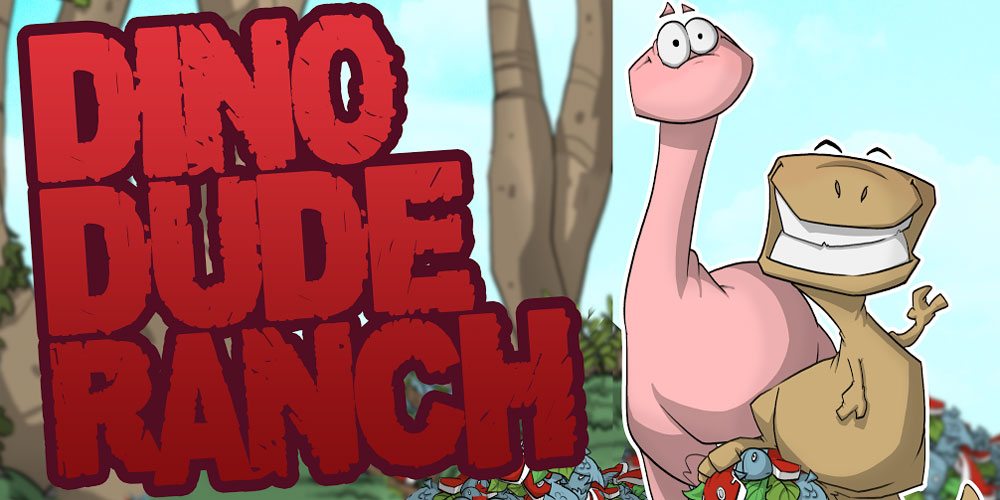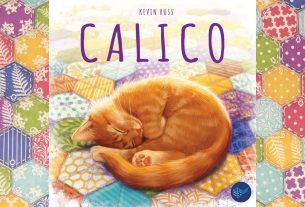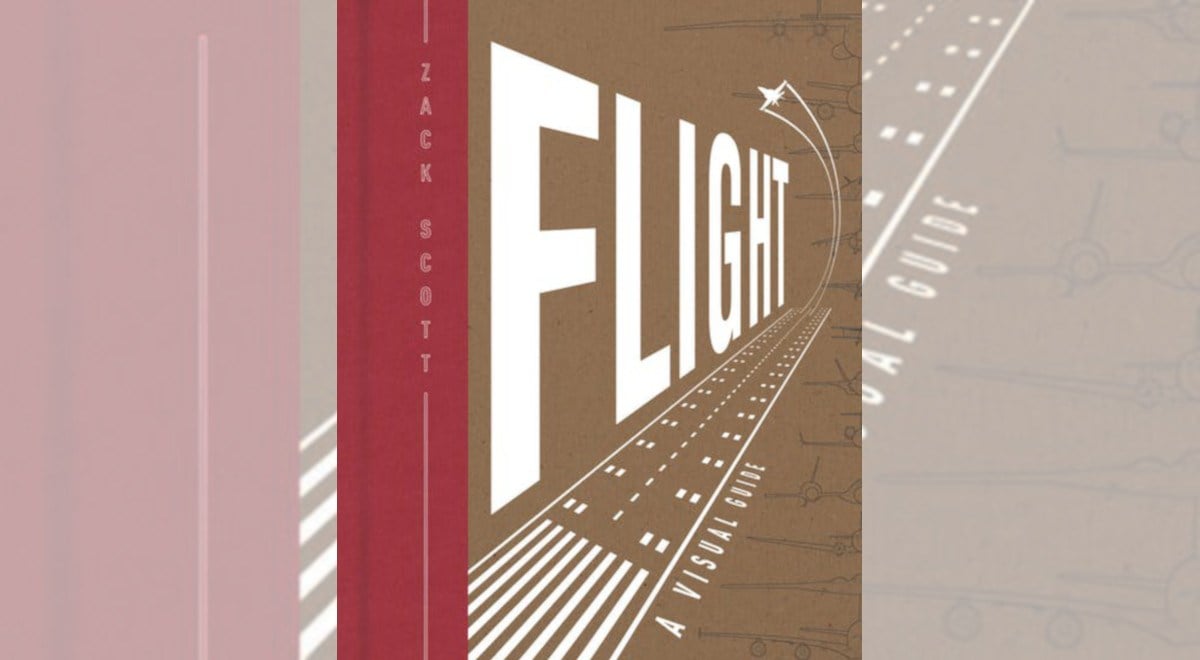As the goblin merchants of Dragon Reach, you know all about the heroes who sweep through dungeons, slay monsters, and return to town with backpacks full of loot. And you know all about the monsters, er, eager customers who are willing to pay top-dollar for anything that might give them an edge against those heroes. If you play your cards just right, you’ll be able to turn a tidy profit! Heroes Welcome!
What Is Heroes Welcome: Merchants of Dragon Reach?
Heroes Welcome is a game by Marc LeBlanc and Eduardo Baraf for 2 to 5 players, ages 14 and up, and takes about 90 minutes to play. It’s currently seeking funding on Kickstarter, with a pledge level of $45 for a copy of the game. The game does have some complexity to it, which is the primary reason for the age rating, but if your kid has some experience with worker placement games and has the patience for a lengthier game, they may be able to handle it. I’d consider most of the humor and thematic elements probably PG; the only potential concern is the theme itself, which involves making profits by playing both sides of a conflict.
New to Kickstarter? Check out our crowdfunding primer, and visit our Kickstarter curated page for more projects we love.

Heroes Welcome Components
Note: My review is based on a prototype copy, so it is subject to change and may not reflect final component quality.
- Game board
- 5 Merchant boards
- 3 Hero boards
- 2 cloth bags (Dungeon and Scrap Heap)
- 17 Building tiles
- 17 Eager Customer cards
- 29 Scam cards
- 12 Mastery cards
- 17 card sliders for Mastery cards
- 65 Loot/Material tokens
- 30 Vorpal Pieces (in 1, 5, and 10 denominations)
- 30 Coins (in 1, 3, 5, and 10 denominations)
- 16 Monster tokens (including 1 boss)
- 5 Potion tokens
- Heroes standee
- Master Merchant standee
- 12 Closed Sign standees
- 5 Reference cards
Kickstarter backers will also get the “Kickbacks expansion” included for free, though my prototype did not include it.
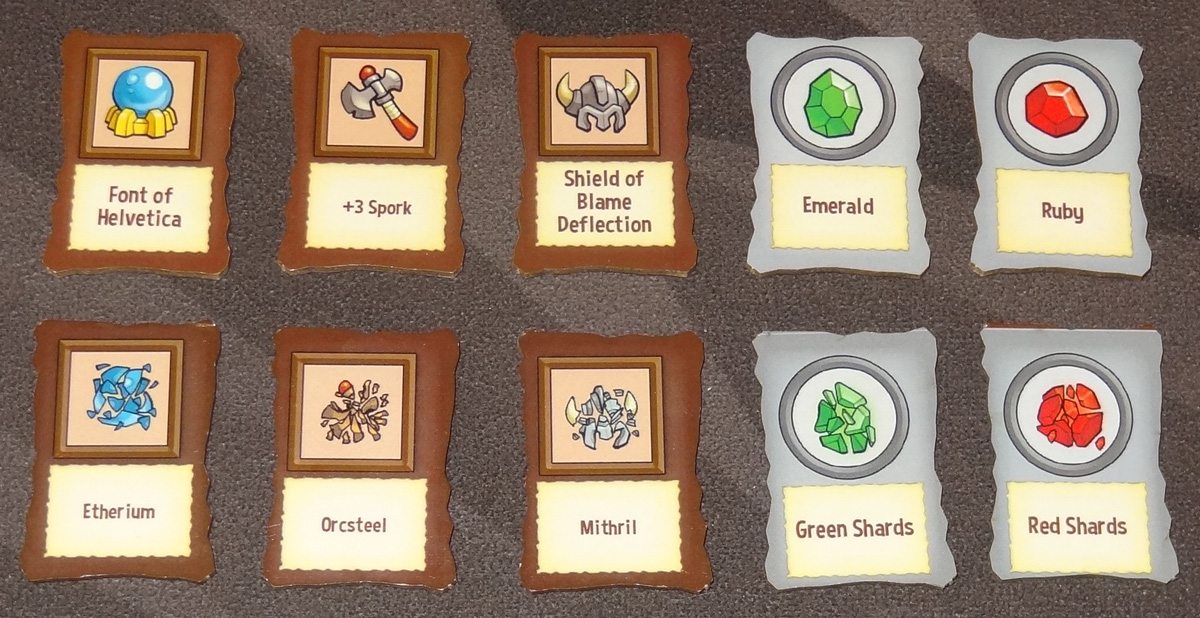
The quality of the prototype was very nice, with only a few minor complaints that may be addressed in the final version. The Loot/Material tokens have loot on one side, and materials on the other: weapons turn into orcsteel, armor turns into mithril, and so on. The material side of the tokens, particularly for the orcsteel and mithril, tend to look fairly similar from a distance since they’re just smashed items. I also wonder whether the Emerald and Ruby will look too similar to color blind players. Everything is labeled with text as well, which is helpful, but it is sometimes important to be able to see what somebody across the table has in their inventory. All of the loot uses the same three icons—doodads, weapons, and armor—but they have unique names, which are hilarious and fantastic. We had a lot of fun reading those out as we drew them out of the bag.

The artwork on everything, by Dustin Foust and Thomas Denmark, is really great—a cartoony style that injects a lot of humor into the game. The “eager customers” are various monsters, and none of them are particularly terrifying—they’re actually sort of goofy. The “boss” is Asmeowdeus, a cat.
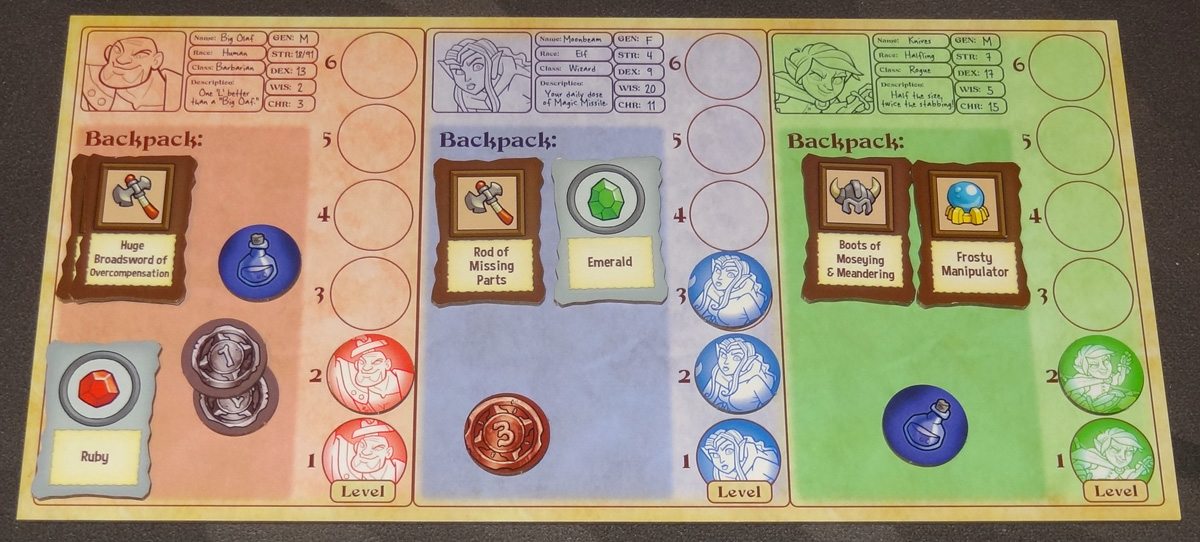
My only other minor gripe is that the hero board (which is one single board in the prototype) doesn’t have quite enough room to hold five types of loot tokens in the backpack area. As the heroes accumulate loot, it’s possible for them be carrying enough that you’ll need to stack them, but it would be nice if there were room to stack five types of loot so that it’s a little easier to keep track of everything. I don’t know if the boards will be larger in the final version, though apparently there will be three of them. Aside from that, the hero boards are nicely done visually: they look a little like character sheets, with the character names and stats and a silly “description.”
How to Play Heroes Welcome
You can download a copy of the rulebook here.
The Goal
The goal of the game is to earn the most Vorpal Pieces (VP) by serving eager customers.
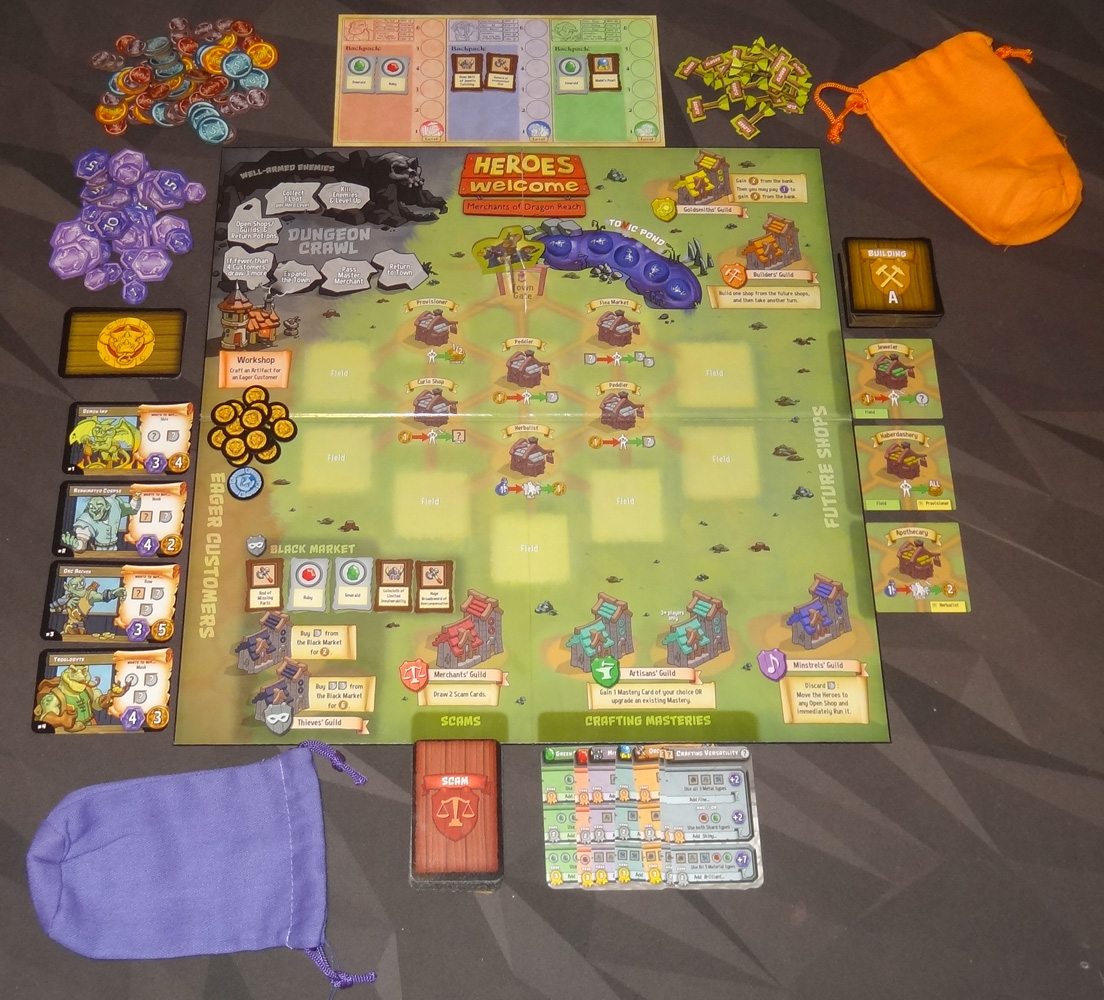
Setup
Place the gameboard on the table. Place the 5 potion tokens in the “tonic pond,” the monster tokens on the monster icon near the Workshop, and five randomly drawn loot tokens in the Black Market. Shuffle the scam cards and place them below the Merchants’ Guild, and place the mastery cards below the Artisans’ Guild.
Separate the building tiles into A and B stacks; shuffle each stack and then place the A stack on top of the B stack next to the Builders’ Guild. Then, reveal the first three building tiles along the edge of the board as “Future Shops.” Put the eager customer cards in numerical order, and reveal the first four cards next to the board where it says “Eager Customers.”
Place the hero boards nearby, with two randomly drawn loot tokens in each backpack. Set the money, VP tokens, and closed signs near the board. Place the heroes standee on the Town Gate space.
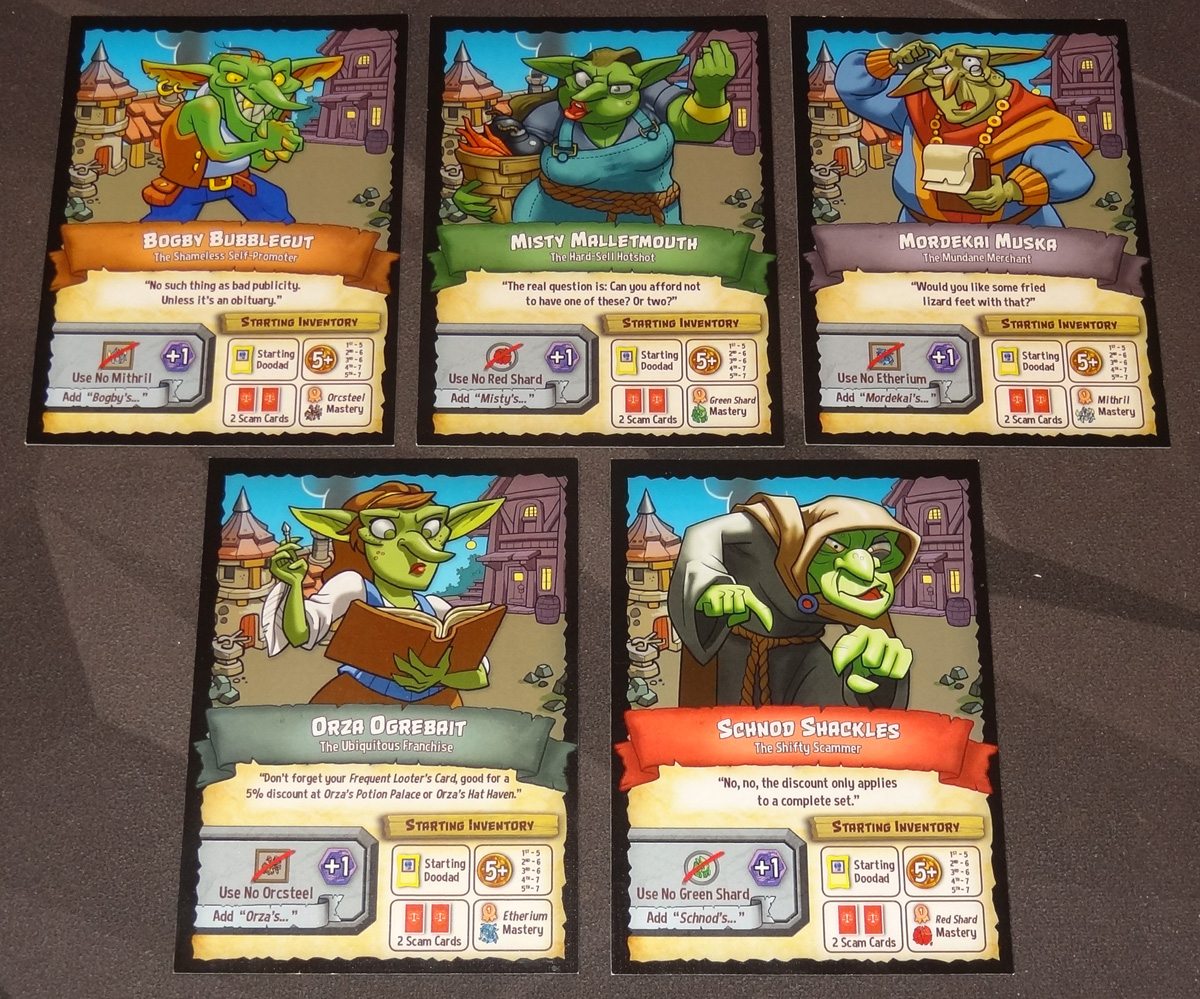
Each player starts with a merchant board, a starting loot token (yellow bordered), two scam cards, and a mastery card as shown on the merchant board (with the slider set at Rank 1).

The player who has the “+1 Ring of Going First” gets the Master Merchant standee. Everyone also starts with some money according to turn order. The starting setup is also printed on the merchant board itself.
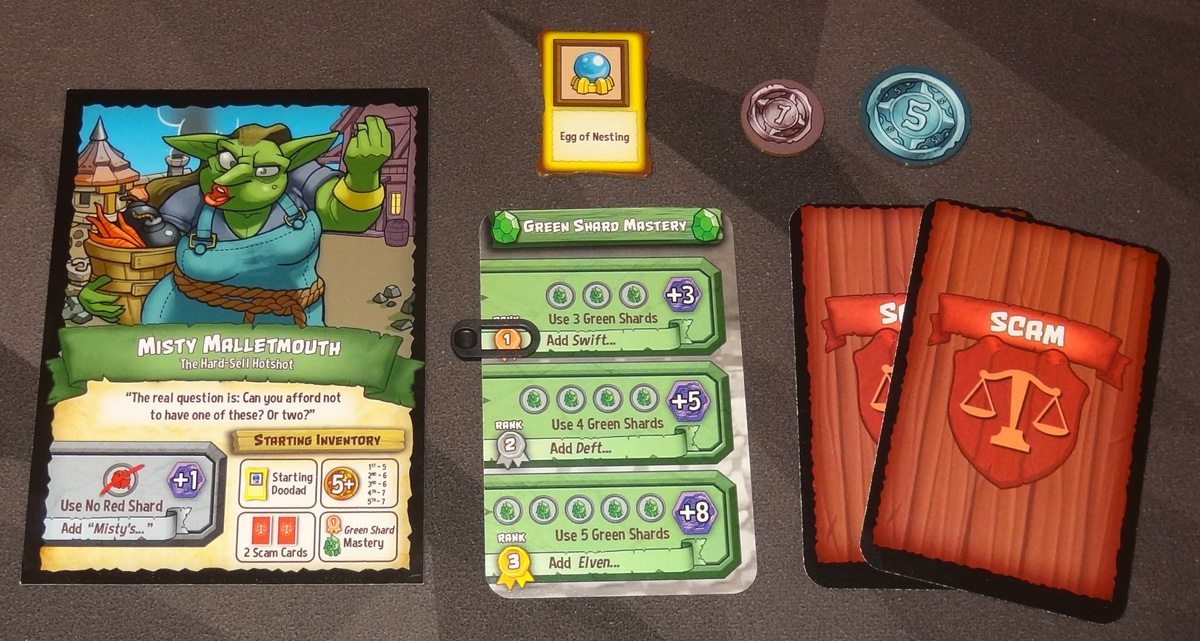
Gameplay
Each round consists of a Town Phase and a Dungeon Crawl Phase. The bulk of the gameplay is in the Town Phase, and then the Dungeon Crawl Phase is somewhat automated.
In the Town Phase, starting with the Master Merchant, each player takes an action:
- Run a shop
- Visit a Guildhall
- Craft an artifact
- Call for round end
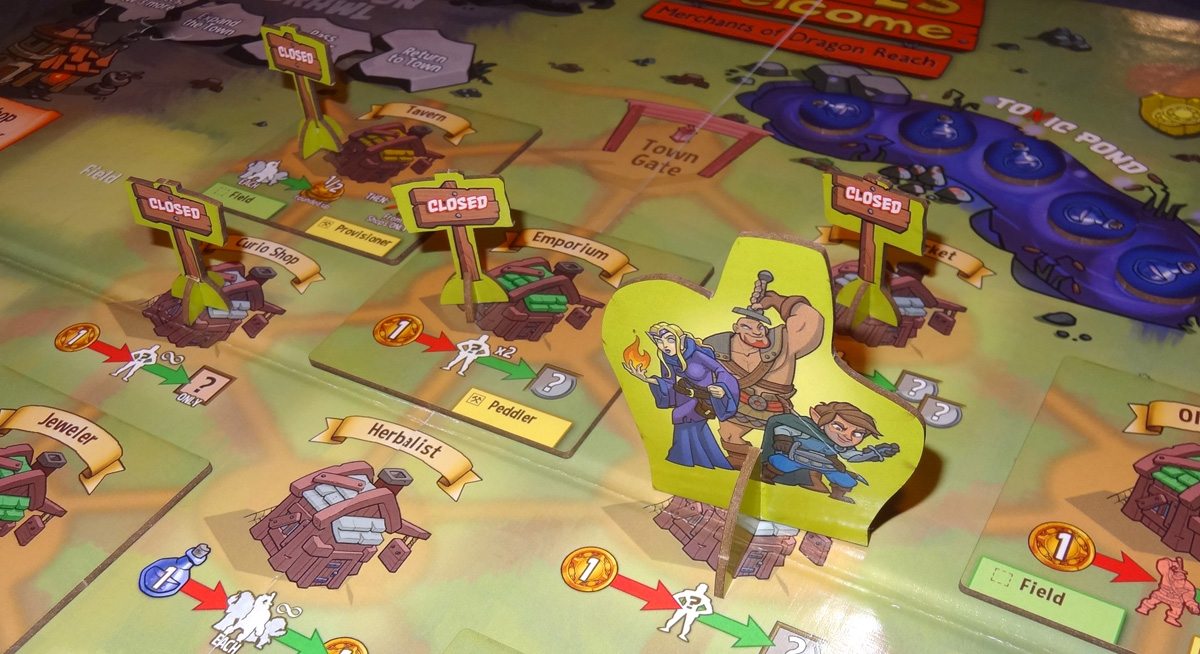
Run a shop
To run a shop, you move the heroes one space along a road to an adjacent shop that is not closed. You may then use the shop’s ability; then, whether you used the shop or not, you put a closed sign on it. Shops have various effects, but generally allow you to trade with the heroes: you might be able to pay them for loot, trade loot, or just take loot. Some shops let you take money from them, and you can also sell them potions to help them level up in the dungeon. Note: if the heroes can’t reach an open shop with one move, then you can’t use this action.
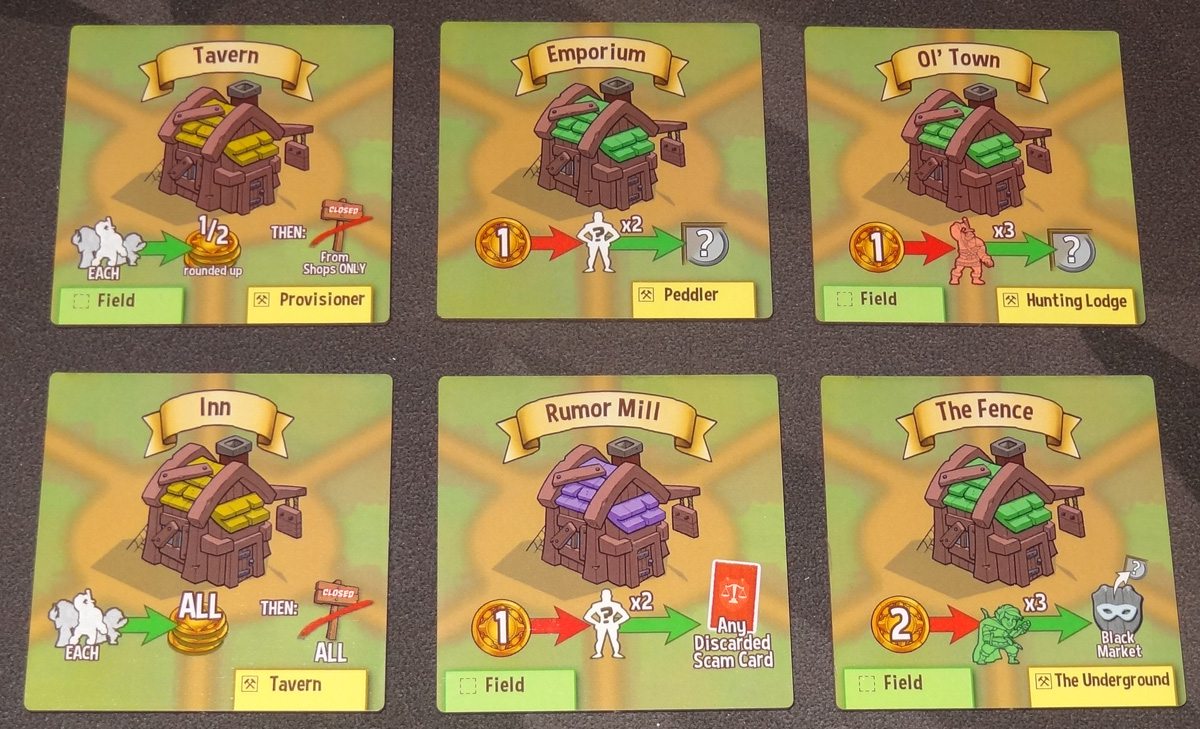
The shops use a system of icons: red arrows indicate what you give, and green arrows indicate what you get. For loot tokens, the square represents an item (weapon, armor, doodad) and the circle represents a gem (emerald, ruby). There’s also a half-circle, half-square icon that represents any loot.

Visit a Guildhall
You may visit any open Guildhall location, use its ability, and then put a closed sign on it. There are two Guildhalls at the top right of the board, and the rest are along the bottom.
- Goldsmiths’ Guild: Get 2 gold from the bank, and you may trade 1 VP for 5 gold.
- Builders’ Guild: Place one of the future shops onto the board, and then take another action. Each shop shows where it may be built—some can be put in empty fields, and some can be built over existing shops. Shops must be built so that they are adjacent to at least two existing shops.
- Thieves’ Guild (two locations): Buy 1 loot from the black market for 2 gold, or buy 2 loot for 6 gold.
- Merchants’ Guild: Draw 2 scam cards. (Any number of scam cards may be played during your turn.)
- Artisans’ Guild (two locations): Take a new mastery card at rank 1, or increase the rank of one of your existing mastery cards.
- Minstrels’ Guild: Discard any loot. Then move the heroes to any open shop and immediately run it.
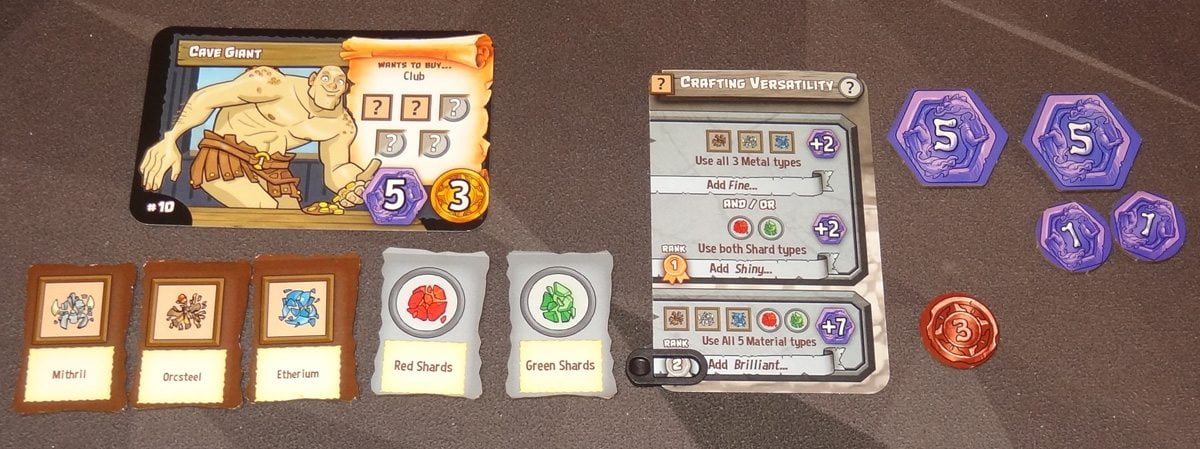
Craft an artifact
You can use the loot that you’ve acquired (from heroes and the black market), “smash” them for raw materials, and then use them to craft an item for an eager customer. Each of the customer cards shows a number of material icons—squares, circles, and square/circles, representing metals, jewels, or any material. The card shows how much VP and gold the monster will pay you for the item.
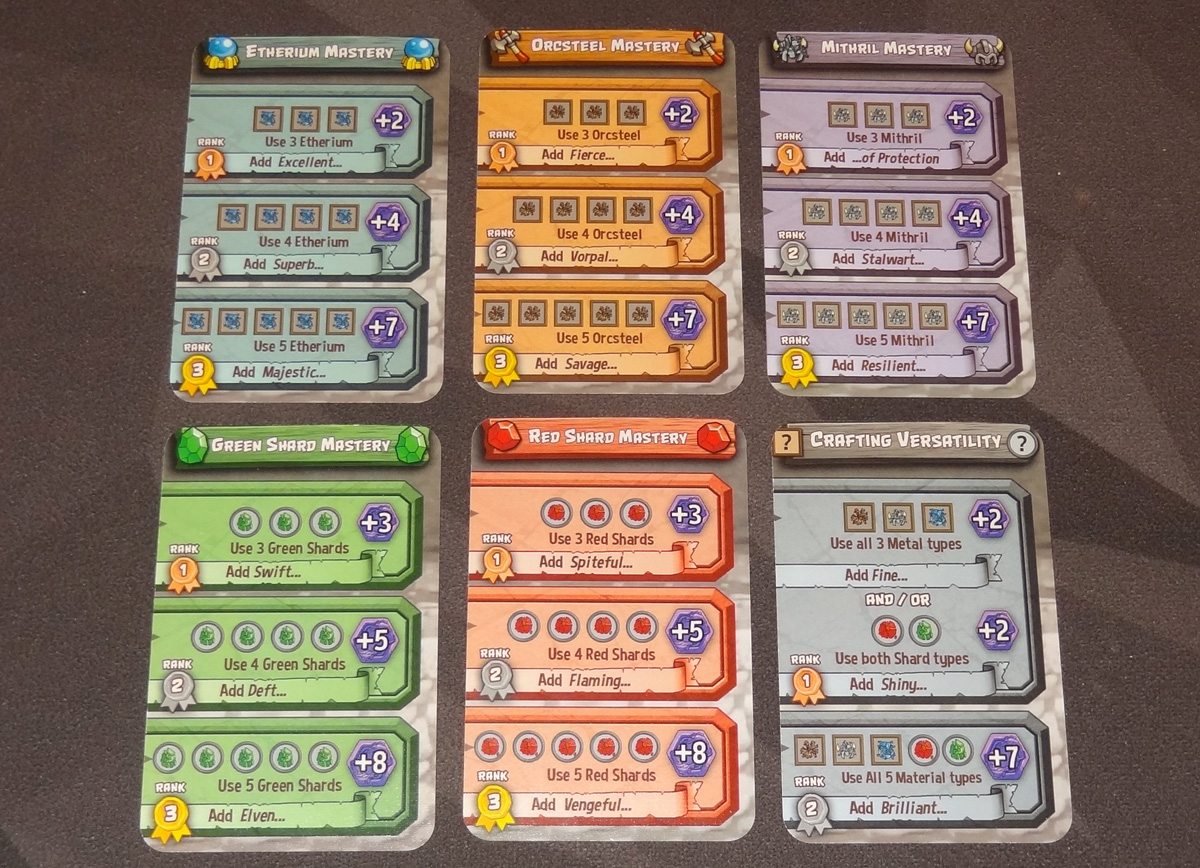
You can also earn bonus VP by using your particular crafting masteries. Each merchant starts with one of these mastery cards, plus a “signature skill” bonus if they avoid using a particular material (shown on their merchant card). You can also gain new masteries or improve existing ones at the Artisans’ Guild. If you use the materials shown, you get the bonus VP, plus you can tack on more adjectives to the name of the item you crafted. (Note: you cannot use more material than required by the customer card.)
After crafting the item, discard the used materials into the scrap bag, take the VP and gold from the supply, and then move one monster token from the monster area into the “Well-Armed Enemies” section of the dungeon. More on those poor suckers later. Finally, take the monster card and place it next to you. (Note: if you craft an item for the boss, put the boss monster token into the dungeon instead of a regular monster.)

Call for round end
You can choose to end the round. In turn order, everyone else has a chance to bribe you by giving you one loot of any kind. If they do, the round continues and it is the briber’s turn next. If nobody bribes you, the round ends and you draw a scam card.
The Town Phase continues, with players taking one action each, until somebody successfully calls for the round end.
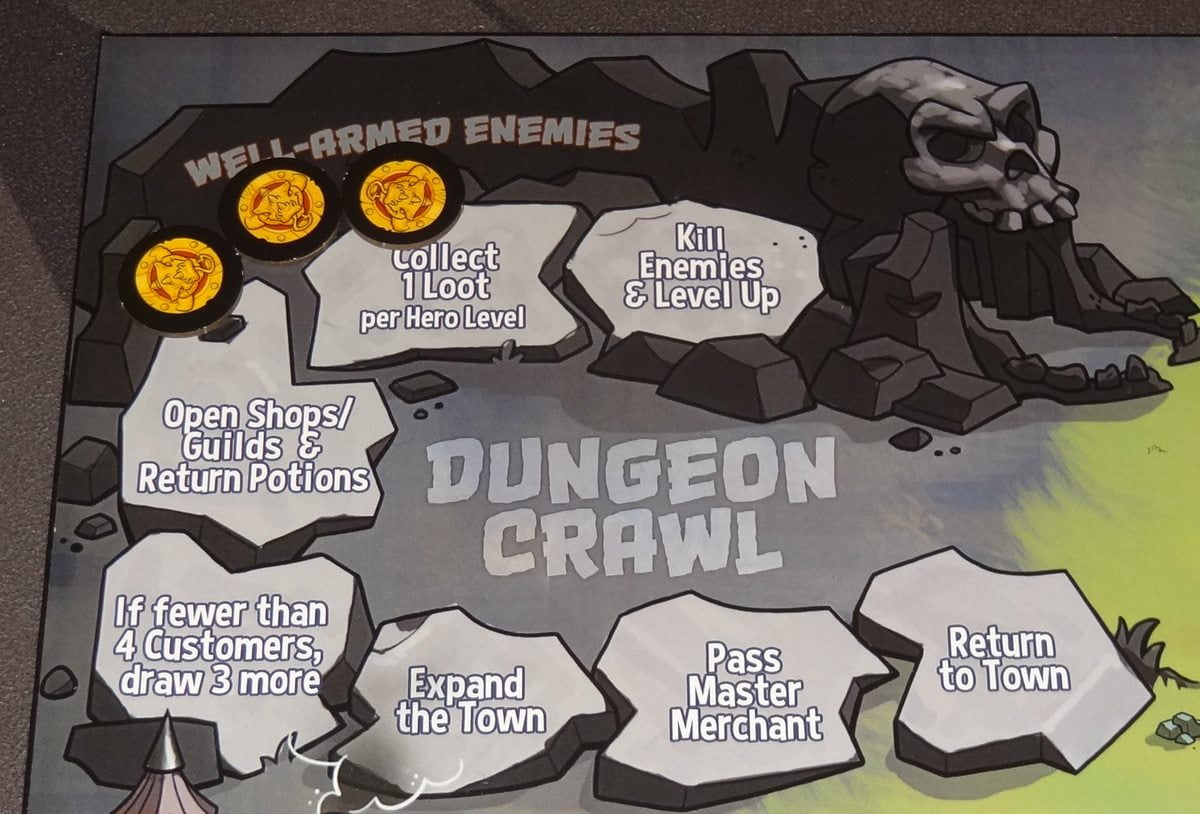
During the Dungeon Crawl Phase, place the heroes standee in the Dungeon Crawl area at the top left of the board. This walks you through the steps of the Dungeon Crawl Phase:
- Kill Enemies and Level Up: Flip over all the monster tokens in the dungeon. Each one has one of the three heroes on the back—these are placed onto their level tracks. Then, if any heroes have potions, those are placed into their level tracks, if there are spaces available.
- Collect Loot: Each hero gets 1 loot from the dungeon bag per level, placed into the backpack.
- Open Shops/Guilds and Return Potions: Remove all the closed signs from the board, and place all potions (used or not) into the tonic pond.
- If fewer than 4 eager customers, draw 3 more.
- Expand the town: The current master merchant draws the top tile of the building stack and places it in town.
- Pass the master merchant standee to the left.
- Return the heroes to the Town Gate and begin another Town Phase.

Game End
The game ends when the boss monster has been killed by the heroes—if that happens, skip the rest of the Dungeon Crawl Phase.
At the end of the game, there is one final crafting phase, shown on the back of the merchant cards. Each player may craft one of the three items shown and earns the VP shown (including using their masteries and signature skill). Then, players may convert their gold to VPs at the rate of 5 gold for 1 VP. The highest score wins, with ties going to most total gold and loot left.

Why You Should Play Heroes Welcome
Heroes Welcome starts with a clever theme, a twist on the usual RPG heroes bravely making their way through dungeons filled with scary monsters. In this game, the heroes are an unstoppable force: no matter how you arm the monsters, they’re never a match for Big Olaf the warrior, Moonbeam the wizard, and Knives the rogue. But you’re not one of the heroes: you’re a goblin, and you might as well make a buck or two off those monsters before they meet their inevitable ends. The heroes are never in any danger—the only question is how much loot they’ll come back with, so that you can buy it from them and craft more artifacts for your doomed, eager customers. It’s a fun play, putting a dungeon crawl theme on a game that is not actually a dungeon crawl itself.
The gameplay is a mix of different mechanics, but it reminds me most of a worker placement game: you place a worker on a spot to use its effect, and also prevent other players from using that spot. However, in this game players don’t have their own worker tokens; instead, the common pool of closed signs serves to mark the spaces that have been used, and the heroes on the town map provide some restrictions on the order that actions may be taken. The Guildhalls are more like a traditional worker placement game: you can take any of them that are free. But the shops in town change the usual dynamic: you can only use shops that are both adjacent and open. Some of the scam cards can help you get around those restrictions, but without them you can get stuck.

That restriction on movement leads to some interesting choices, too: you might really want to buy some loot from a hero, but moving them onto that shop puts them adjacent to another location that will let somebody else take a pile of money from the heroes. You’ll have to weigh your need for loot with the advantage that you’re giving somebody else. Or maybe you just play a “Gone Fishing” scam card to shut down that other store entirely. Just remember: if you trap the heroes for another player, you’ve also limited your own possibilities as well!
Another big component of the game is the resource management: how do you get the resources you need to craft an artifact? Which artifact should you craft—the one that gives you more money (to get more resources) or the one that gives you more points? On top of that, the crafting masteries give you the option of using specific materials to bump up the point value of artifacts, but that may mean taking more time to acquire those materials.

And, of course, while you’re out there collecting a pile of emeralds so you can create Misty’s Deft Axe for the Orc Warrior, another player might sneak in and serve the customer before you because they just slapped together any old resources! Since everyone’s resources are public knowledge and the customers will buy from anyone, it’s important to keep an eye on what other players are doing. As they say, the early merchant gets the vorpal pieces.
I did find myself wishing that the customers weren’t always the same. There are 15 monsters, followed by a boss, and they always appear in numerical order. It makes sense, because the earlier ones require fewer materials and the later ones require more—and you’ll be hard-pressed to get that many materials early in the game. So the requirements for artifacts do need to ramp up as the game progresses. On the other hand, it does mean that line of customers will just look the same every time you play.
The shops, on the other hand, will have a bit more variety. The starting shops (printed on the board) are the same each time, but the order that shops will be drawn from the deck will vary, and the locations that they’re built will also change from game to game. In particular, there are sometimes multiple choices where you could build any given shop, so the layout of the town will rarely be the same. I did find, though, that we rarely got to build more than a few buildings from the “B” set of buildings before the game ended, so you can’t really count on those buildings making it to the board each time.
The game is published by Pencil First Games and Monkey Jump Games. You may be familiar with Pencil First Games already since we’ve written about many of their Kickstarters before, like Lift Off!, Herbaceous, and Legendary Creatures, among others. It has definitely become a trusted name in the Kickstarter tabletop space over the years. The prototype was quite polished looking already, and so I’m sure the finished version of Heroes Welcome will be well-produced, too.
Overall, I enjoyed playing Heroes Welcome (before I had to ship the prototype off to the next reviewer, alas) and I thought it was a fun spin on worker placement games. The game does a good job of making you feel like a goblin merchant, constantly trying to lure the band of heroes to this shop or that so you can get your hands on their loot or their money, and then slapping together artifacts to sell to those poor fools on their way into the dungeon. I love the humor in the game, too—it adds a lot of laughs to what could have been a dry experience with a different theme.
For more information or to make a pledge, visit the Heroes Welcome Kickstarter page!
Click here to see all our tabletop game reviews.
If you’d like to stay up-to-date with all of our tabletop gaming coverage, please copy this link and add it to your RSS reader.
Disclosure: GeekDad received a copy of this game for review purposes.




